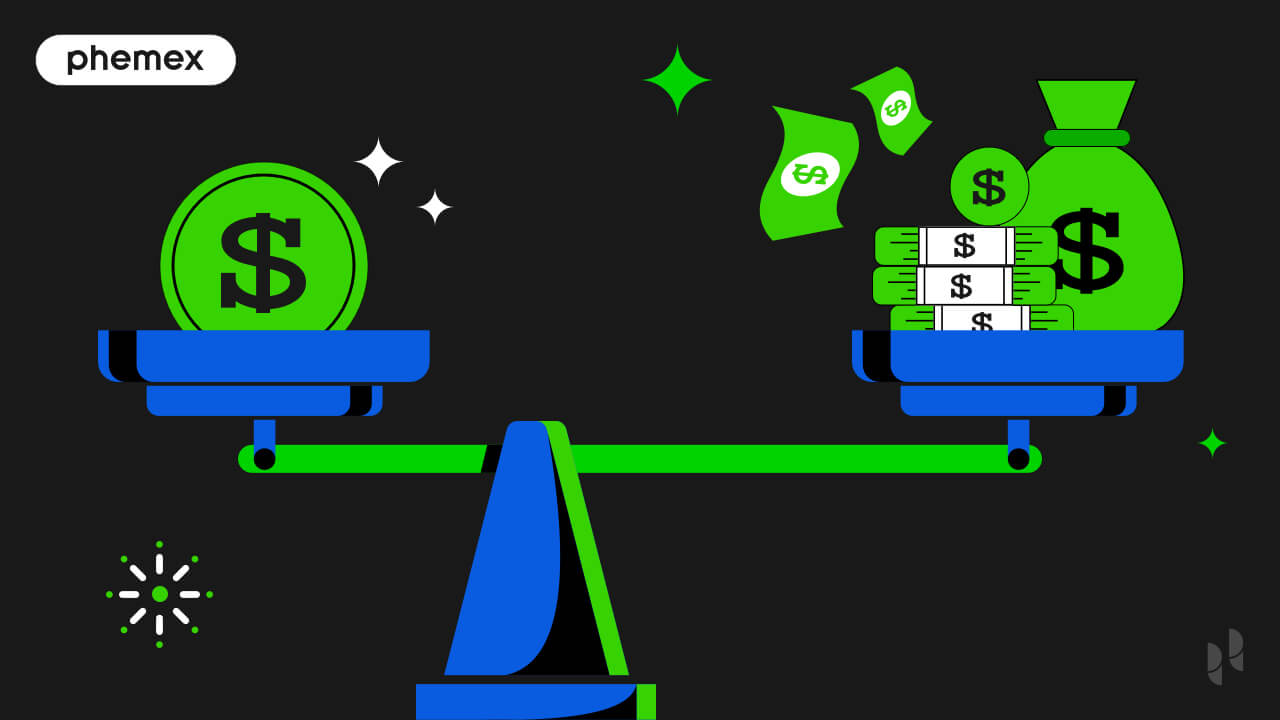Leverage trading is an investment strategy where traders borrow funds from their broker or bank to increase their profits. This means they can invest more capital into a trade than they can usually access, enabling them to take more significant risks. However, if the trade doesn’t go well, the trader could lose more than their initial investment.

What Is Leverage Trading?
Leverage trading is a system that allows traders to open much larger positions than would be possible with their own capital. Traders need only invest a certain percentage of the position.
For instance, a broker offering 10x leverage enables traders to open a $10,000 position with just $1,000 in upfront capital.
So if you invest $1,000 directly into BTC, expecting a 10% rise in value, you will profit by $100 if the market goes your way. Additionally, the market would have to crash by 100% for you to lose your entire investment. At a 10x margin, the same trade would net you $1,000 in profit, but the market would only have to dip by 10% to wipe you out completely, and position sensitivity to price movements only increases with leverage.
Terms Related To Leverage Trading
- Buying power: The capital accessible to an investor (including leverage) to buy securities.
- Coverage: A fundamental indicator for investors, Coverage represents the ratio of the net account balance to the leveraged amount and the money owed.
- Margin calls: If coverage or risk ratio falls below a certain threshold, the platform will issue a margin call to maintain the leveraged position. During margin calls, the platform will close placed market orders that haven’t yet been executed. If the leveraged amount cannot be recovered completely, even after canceling these pending orders, the investor’s positions are automatically closed in a specific sequence. Investors must manage their own market risks, closing positions before the coverage ratio reaches the minimum required level.
How Leverage Trading Works
Understanding how leverage works is vital for any trader looking to take advantage of this strategy. When you trade using leverage, you’re essentially borrowing money from your broker to increase your position size. For example, if you’re selling $1,000 with 2:1 leverage, you can buy $2,000 worth of assets.
You’ll make a profit if the trade is successful and the asset’s price goes up. However, if the asset’s price falls, you’ll make a loss.
This is because you’re responsible only for the initial margin put down to open the trade. The broker covers the rest. This means that you can make a lot more money than if you were just trading with your own capital, but it also means that you’re at greater risk of making a loss.
Does Leverage Increase Profit?
Leverage can help you to make more profit from a trade, but it can also increase your losses.
Say your broker offers you 100:1 leverage, meaning you can open positions worth $100,000 with just $1,000 capital. You then buy 100,000 units of the EUR/USD currency pair at $1.15 per unit. With leverage, you only need to put up $1,150 of your own money (1.1500 x 100,000 units / 100x leverage). The rest is borrowed from your broker, making your position worth $115,000.
If the market rises by just 5%, your position becomes worth $120,750, giving you 5x profit ($120,750-$115,000=$5,750) on your initial $1,150 investment.
Can You Lose More Than You Invest With Leverage?
Let’s say you’re using 100:1 leverage, buying 100,000 units of the EUR/USD currency pair at 1.1500. Your position is worth $115,000 (100,000 x 1.1500) using just $1,150 worth of capital.
Like before, your profits are exponentially higher if the market goes up, but the market would only have to fall by 1% to lose your entire $1,150 investment.
As you can see, leverage can amplify both your profits and losses.

Leverage Trading In Crypto Explained
Leverage is one of the most misunderstood terms in crypto trading. In fact, it’s often used interchangeably with margin trading. But these concepts are very different.
Margin trading uses borrowed money to amplify your buying or selling power, whereas leverage multiplies your initial investment. The amount of leverage is described in terms like 5:1 (5x), 10:1 (10x), or 20:1 (20x). These ratios show how many times your initial investment is multiplied. So if you spend 1 BTC to open a position worth 10 BTC, you’re using 10x leverage.
How Much Leverage Is In Crypto?
In crypto, there are no regulatory limits on how much leverage can be offered. However, some brokers may limit the maximum amount of leverage for specific pairs..
Some exchanges don’t impose these restrictions, while others don’t offer leverage at all. The best way to find out what leverage options are available is to check the exchange or broker’s website.
How To Leverage Crypto: A Step-By-Step Guide
Step 1: Open an account
First, you’ll need to sign up for an account on a crypto exchange such as Phemex.
Step 2: Deposit funds
Once you’ve opened an account, you’ll want to deposit fiat currency into it. For non-verified accounts, which have not completed the KYC process, the exchange may limit the amount of money you can deposit, withdraw, and leverage.
Step 3: Select your coin
Once you’ve chosen your platform, you’ll need to select your coin. There are thousands of cryptocurrencies in existence, and no exchange lists them all. However, the most popular cryptocurrencies and digital assets are available on almost every exchange.
Step 4: Set your order type
Now that you know which coin you want to trade, you’ll need to decide whether you’re going long or short. Long positions involve investing in the expectation that the value of a coin will rise over time. Short positions work just the opposite, you expect the value of a coin to fall.
You can set your order type when placing your order. Once you place an order, you won’t be able to change it until after the market closes.
Step 5: Place your order
You’ll now need to place your order. Your order will contain two parts: the price you want to trade an asset at, and the number of tokens you wish to purchase or sell.
If you’re buying, enter the desired purchase price and the number of units you want. If you’re selling, enter the price at where you’d like to sell and the number of units on offer.
What Happens If You Lose Leverage In Crypto?
Leverage works by borrowing more than you have. When you borrow money, you agree to pay interest on top of whatever you borrowed. If you borrow $100 at 5% interest per annum, you’ll owe an additional $5 each year you cannot pay the lender back.
The same principle applies to cryptocurrency markets, and it’s not uncommon for traders to get burned when they borrow too much.

Where To Leverage Trade Crypto?
There are many places online where you can leverage trade. Phemex allows you to trade with up to 100x leverage and provides a comprehensive platform for both spot and derivatives.
How To Do Crypto Taxes With Leverage Trading?
Depending on where you live, your leveraged cryptocurrency trades may be subject to capital gains tax (CGT). This tax is levied as a percentage of your profit.
For example, say you purchased $1,000 in BTC with 10x leverage, creating a $10,000 long position. If the price of Bitcoin rose by 10%, you’d make $1,000 in profit. At 20% CGT, you would owe $200 in taxes.
Should You Trade With Leverage As A Beginner?
Many experienced investors depend heavily on leverage to make their money. The problem is that inexperienced traders often don’t understand what they’re doing and take significant losses. That said, there are some things you can do to minimize risk, like limiting your trades to small quantities and avoiding margin trading altogether.
How Much Leverage Is Too Much? What Leverage Should A Beginner Use?
It’s recommended for beginners to start out using low leverage, if not zero leverage. Many experts also recommend leveraging only 1% of your total portfolio value. As you gain experience, you may prefer higher levels of leverage. A good rule for beginners is to keep less than 5% of your portfolio in leveraged positions. This way, you’ll always have enough money to cover losses.
What Are The Pros & Cons Of Leverage Trading?
Advantages Of Leverage Trading
1 Leverage Trading Minimizes The Capital The Traders Invest
Instead of paying the full price for an instrument, the trader can pay only a small portion of it.
Let’s see an example: if a position’s value at the time of opening is $3,000, instead of paying the full amount, he can employ leverage of 400:1. This means that every $400 in actual value he will be requested to invest $1 of his own capital; meaning that for this position he will need $7.5 to open it.
2 Some Instruments Of Leverage Trading Are Relatively Cheap
Some instruments are relatively cheap, meaning almost every trader can trade them easily. In another way, some are considered more valuable and based on their traded frequency and other factors are more costly. Instead of investing large amounts in order to take part in their market, it is possible to use leverage and enjoy the shifts in the price of valuable instruments.
Drawbacks To Leverage Trading
Although leverage trading lets traders earn more from smaller investments, failed trades have significant risks. It is crucial to keep track of open positions, setting stops and other market orders to prevent large-scale losses.
For this reason, it’s always best to approach leverage with caution, no matter your level of expertise. Using an intuitive, trustworthy crypto exchange platform like Phemex will help you make safer and more accurate trades and trading decisions.









